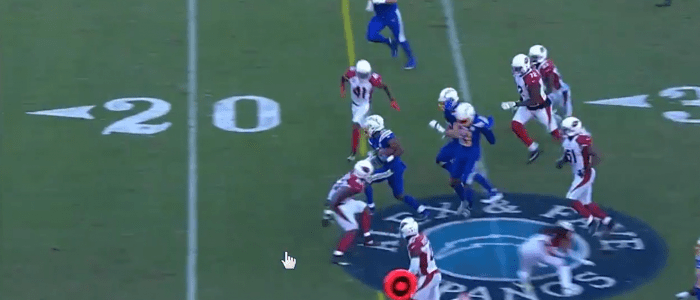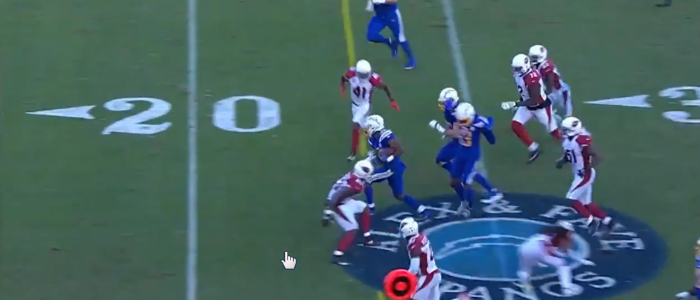
Matt Waldman’s Rookie Scouting Portfolio shares its pre-draft sample report of Chargers running back Justin Jackson.
Melvin Gordon will miss multiple weeks with a Grade 2 sprain of his MCL. Austin Ekeler will earn the start in Gordon’s place but as we’ve seen in Los Angeles, there is room for two productive backs in the Chargers backfield.
Rookie Justin Jackson was one of the most underrated runners in this excellent 2018 draft class. After missing all but a day of training camp due to a hamstring injury, Jackson gutted through the ailment to play the final preseason game before landing on the Chargers’ practice squad.
By the Chargers’ game in London, Jackson earned an active roster spot and a role on special teams. This weekend, Jackson earned time in the backfield and made a good impression in limited time against the Cardinals. In case you want to see more, here are two more clips: 1 and 2.
Here’s Jackson’s scouting report from the 2018 Rookie Scouting Portfolio. If you’ve never purchased the RSP publication, it’s a .PDF available for download every April 1 and comes with a post-draft update that’s available no later than one week after the NFL Draft plus a monthly newsletter with updates from June through December.
You can take the video tour and learn more here.
There will be a pre-order discount period (10 percent off) announced in December for the 2019 RSP publication. Follow this site or @mattwaldman on Twitter for updates.
7. Justin Jackson, Northwestern (6-0, 199)
Depth of Talent Score: 81.4 = Rotational Starter: Executes at a starter level in a role that plays to his strengths.
Justin Jackson is a bad-ass college running back who I think has a better than a projected chance of becoming a bad-ass NFL running back despite a 190-ish-pound frame. His skills and traits compensate for a simple lack of size.
Jackson is far from Donnel Pumphrey-small and far more skilled than Ronnie Hillman. Jackson is more like Clinton Portis when Portis was the University of Miami’s super back at a weight between 185-190 pounds. Jackson’s thin frame may have enough capacity to add another 5-15 pounds while maintaining his extreme quickness.
Dare I say Jackson reminds me even more of Jamaal Charles? His talent is within the region of Charles’ game, maybe even the same city. If he had shown up at the NFL Combine weighing at least 205 pounds and still delivered as he did in the workouts, I might have moved Jackson into Charles’ zip code.
Although I haven’t gone that far, his tape shows a runner with a tremendous skill for using contact to his advantage. He knows how to prepare for it, deliver it as the aggressor, and work off it for positive yards. This is exactly what I noted from Charles’ game in 2008. Charles arrived at the NFL Combine at 6’1”, 200 pounds.
He ran a 4.38-second 40-yard dash; a 4.22-second 20 Shuttle; and a 6.8-second Three Cone. Jackson is an inch shorter and seven pounds lighter, which makes his athletic proportions pretty similar. He lacks the dangerous long speed of Charles (4.52-second, 40) but his 4.07-second 20 Shuttle; 6.81-second
Three Cone; and 38.5-inch vertical indicates his short area quickness and acceleration are on-par or better than Charles at the same point of their careers.
Jackson’s explosive short-area quickness and methods of using it on the field reminded me of Charles when I watched Jackson for the first time in July. His Combine performance is further validation that his metrics show the two backs as athletically similar.
Jackson is an intelligent, dynamic runner. He hits creases decisively and maintains strong pad level throughout. His quickness, flexibility, and pad level help him work under defensive lineman. When forced to take on linebackers downhill in short-yardage situations, Jackson can remain upright and keep his legs driving to earn yards after contact. While unlikely that he’ll do this nearly as often against larger NFL linebackers, Jackson has the tricks in his bag that helped Charles, Chris Johnson, and early-career Clinton Portis work effectively between the tackles.
That bag has a special bottomless compartment of moves to set up rushing lanes and make defenders miss. Jackson drops his weight easily to make sharp cuts—even when cutting downhill after working towards the sideline at full speed. It’s a fun sight to see Jackson avoid edge containment with this kind of agility.
Between the tackles, Jackson varies his stride length before attacking the crease and displays an
understanding of the scheme design. If caught in the backfield or if the quarterback doesn’t switch the play to the side away from the defense’s numbers advantage, Jackson is quick enough to reverse field and earn the opposite corner.
Like all of the runners I mentioned above, Jackson’s quickness and agility help him eliminate direct angles of contact. Because he knows how to use his agility with the aggressive mentality on defenders, he has cultivated that same slippery power of his predecessors.
He runs with a wiggle that’s troublesome for defenders to get a bead on, and he bounces off hits as the aggressor into contact. His pad level not only helps him get under defenders, but he can use it to deliver the first glancing blow to slide or spring over the top of a defender. This helps Jackson extend past the contact for as much as 3-5 more yards and makes him a dangerous finisher in the red zone when he reaches the perimeter.
Jackson’s stiff-arm is one of the best tools in his bag. I didn’t see a running back this year—or any other year I can recall—whose accuracy of placement with the stiff-arm is as good as Jackson’s. Whether it’s the baby flipper or a fully extended straight-arm, Jackson finds the ideal placement point on the helmet, shoulder or chest to achieve the desired leverage that prevents the opponent from getting a good grip on him.
He can deliver it straight-on, as he approaches the defender as a leverage point to pull past the pursuit, or as he’s passing the opponent to ensure no dive will reach him. He can also modify it to a forearm shiver that he’ll use to strike and spin or strike and extend over the top of the defender shooting at his legs.
Jackson executes a versatile range of plays. He ran zone and gap plays in the Northwestern offense. He
anticipates run blitzes and adjusts. He also transforms potential losses due to early penetration into short gains.
When running behind gap blocks, Jackson will use efficient footwork to allow his blocks to set up and then hit the resulting crease with great burst. He’ll press close enough to the line as a zone runner to set up a wider cutback. When the Wildcats ran the option, Jackson effectively pressed creases to the edge and cuts downhill.
He hits creases with confidence and his pad usage is more versatile than the average runner. He’s adept at making multiple defenders miss in close quarters, knowing when to attack an opponent and when to
accelerate his pace so he has an edge at the collision point.
All the while, Jackson is aware of ideal leverage points to use that stiff-arm to ward off contact. When knocked off balance, he has an effective balance-touch technique to regain his stride or at least extend the play for positive yards.
Because his acceleration is strong and change of direction precise, Jackson would do well in a scheme that runs a lot of outside zone. The Seahawks, 49ers, and Falcons would all be great fits—especially Seattle, who could use a lightning-quick back who can create intelligently against backfield penetration and also bail out Russell Wilson as an outlet when the offensive line doesn’t hold up.
Jackson is a good route runner from the backfield, snapping his hips suddenly at the top of his stems to
earn quick separation against linebackers and safeties. He catches the ball with his hands and adjusts to the path of the ball on downfield routes so he can turn through the reception into the open field.
He understands when to use the appropriate high or low hands technique based on the location of the target. Although he’s made plays against contact, he often drops as many of these targets as he catches. He also experiences lapses of concentration with off-target adjustments that are catchable. Despite these lapses, it’s worth noting that he had 44 catches last year and 122 in his career.
Jackson will never be the first choice to stand-down a defensive end in the passing game but has skills to build on. He’s willing to square and deliver his hands with a good position against edge defenders. He’ll also set up early and extend his arms into contact with blitzing linebackers.
Although he’ll win some of these confrontations without help, a linebacker up the middle will always have the edge. Jackson is much more effective as a cut blocker or standing up defensive backs and undersized outside linebackers. Jackson’s cut blocks consistently have good height and position to the appropriate leg of the opponent. Defensive backs can shake Jackson out of position when he’s protecting the edge.
Ball security and workload have not been a problem. Jackson has 1,265 career touches as a four-year starter in the Big 10 and only 7 fumbles for a rate of 1 per 181—top-tier efficiency.
Every year there are concerns about college backs with high-volume workloads. Many of the NFL’s best feature backs had heavy workloads in college and continued earning that volume for several years in the NFL without a problem, including Adrian Peterson, Marshawn Lynch, Ray Rice, DeAngelo Williams, and LaDainian Tomlinson. Saturday volume is positive for Sundays if the player remains healthy throughout his career.
Jackson is the 11th ranked rusher in college history and No. 6 on the all-time attempts list. The question shouldn’t be about him holding up but how productive his style of play will be and if there’s a team that’s open to the potential fit as more than a just role-player.
RSP Boiler Room Festival: Justin Jackson
RSP Twitter Vids: Justin Jackson
Matt Waldman's RSP: RB Justin Jackson
Pre-NFL Draft Fantasy Advice: Jackson’s metrics and production may be in the neighborhood of Jamaal Charles but his reputation is not. If he’s a mid-round pick, it will be a moderate surprise to me. Expect Jackson to earn a Day Three pick at best and his new team regarding him as an intriguing reserve.
Unless he makes a strong impression early and vaults up the depth chart this summer, he’ll probably have to wait until mid-year to see playing time. He’s a patience play with potential long-term value.
For analysis of skill players in the 2018 draft class, download Matt Waldman’s 2017 Rookie Scouting Portfolio today! Better yet, if you’re a fantasy owner the Post-Draft Add-on comes with the 2012 – 2017 RSPs at no additional charge. Best, yet, 10 percent of every sale is donated to Darkness to Light to combat sexual abuse. You can purchase past editions of the Rookie Scouting Portfolio for just $9.95 apiece.

